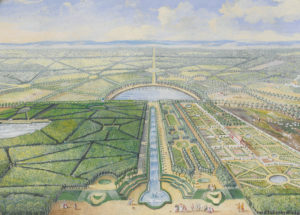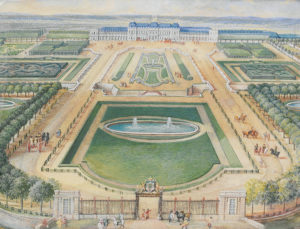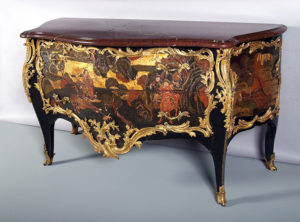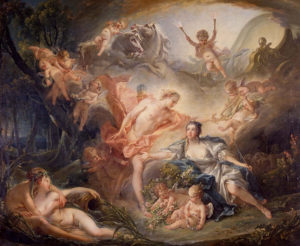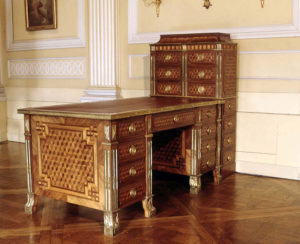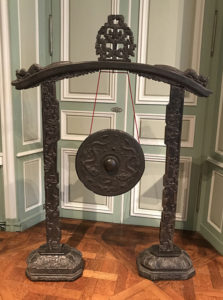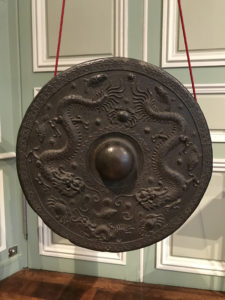Vestiges of the Château de Chanteloup in Tours
EVENTS > STUDY TRIPS ABROAD
STUDY TRIP ABROAD FALL 2019 IN REVIEW
Magnificent architecture, superb collections, private house visits, and delectable wine and cuisine contributed to our fabulous immersion during the fall’s Loire Valley Study Trip Abroad. We introduced participants to the region’s evolution from a series of contested military strongholds to extravagant country retreats, with the flourishing of grand châteaux from the Renaissance onward. Among the most important decorative arts collections we encountered, however, is one tied to a château that no longer exists. The rise and fall of the opulent Château de Chanteloup is a story for the ages.
King Louis XV’s prime minister, Étienne-François de Choiseul-Stainville, duc de Choiseul (1719–1785), enlarged this splendid country retreat near Amboise, built in 1711 for Jean Bouteroue d’Aubigny. A descendant of d’Aubigny sold the château in 1761 to Choiseul, who also acquired adjoining land, increasing the size of the estate to 11,000 acres. The elaborate gardens were compared by some contemporaries to Versailles, but those at Chanteloup were nearly twice the size.
Choiseul engaged the architect Louis-Denis Le Camus to modernize and enlarge the château. Among the most important illustrations of this renovation and expansion campaign are the miniatures incorporated in a gold snuff box commissioned by Choiseul in 1767 from artist Louis-Nicolas Van Blarenberghe (1716–1794) (figures 1 and 2). As a veritable exclamation mark for the garden, Choiseul commissioned the Pagode de Chanteloup (figure 3) for a jardin anglo-chinois that replaced the French formal gardens east of the main axis of the château. Built in 1775 by Le Camus, the 144-foot-tall pagoda was located just to the north of a demi-lune lake created at the end of a long canal stretching from the château (figure 2).
Choiseul fell in and out of favor with the royal family over the course of his life, banished from Versailles by Louis XV in 1770 until his reputation was restored under Louis XVI in 1775. After Choiseul’s death in 1785, the château was purchased by the duc de Penthièvre, but the French Revolution precipitated a period of decline. The property and contents were seized in 1793. Although some furnishings were sold in 1794, the bulk of the collection remained in the public domain. The house was mostly demolished in 1823, but some features of the park remain. The pagoda stands as a sentinel of this once-extraordinary estate.
The decorative and fine arts from Chanteloup on display at the Musée des Beaux Arts in Tours offer a tantalizing-if-fragmentary glimpse of the duc de Choiseul’s interiors. Located in an 18th-century building that was once the Archbishop’s Palace, the museum galleries are perfectly proportioned for the extant Chanteloup furnishings and paintings on display. In line with his standing in high society, Choiseul patronized the leading artists and artisans of the day.
Of particular note is a mid-18th-century commode with lacquer panels (figure 5) that foreshadows Choiseul’s interest in the exoticism of Asian design. The chest is marked by Jean Demoulin, a cabinetmaker born in Côte-d’Or, who rose to prominence in Paris as a leading purveyor of Rococo furniture in the chinoiserie taste. Demoulin excelled at the manipulation of flat panels of imported lacquerwork to the curvaceous facades of fashionable French furniture. The scene depicted on the Chanteloup commode is of outlaws hunting. The applied gilt mounts are equally impressive, with meandering foliage, flowers, and volutes outlining the drawers. The commode was used by Madame de Choiseul, implying an attachment to older furnishings at Chanteloup. An inventory of the contents from the time of the French Revolution suggests that Choiseiul also owned lacquer screens and boxes.
Choiseul incorporated an impressive selection of mid-18th-century fine art in his Loire château, including a handful of paintings by Francois Boucher, whose work is synonymous with the French Rococo style. Boucher’s Apollo Revealing His Identity to the Shepherdess (figure 5) was commissioned for another house before arriving at Chanteloup a decade later. Boucher often rendered scenes of Classical mythology, and this picture is pulled from Ovid’s Metamorphoses. As with the commode described above, the composition is defined by a sequence of curves, creating a spiraling movement that unites the figures in their natural surroundings.
A stunning inlaid-marquetry desk (figure 6) and cabinet from Chanteloup is attributed to Simon Oeben, the brother of a more famous cabinet maker, Jean-François Oeben, who was appointed an official supplier to Louis XV in 1754. Born in Aix-la-Chapelle, the brothers initially shared workshop space in Paris and often mimicked each other’s designs. Known as a bureau-cartonnier, the desk personifies a variant of early French Neoclassicism referred to as goût grec. The cubic pattern of the marquetry was introduced by Jean-François Oeben around 1760, but the bronze mounts on the feet and cabinet are tied to Simon. The masculine character, imposing proportions, and restrained ornamentation suggest that Choiseul commissioned the desk for his personal use.
According to tradition, Choiseul acquired a stunning ceremonial gong (figure 7) for use in the aforementioned pagoda. Referred to as a suspended gong, the carved Zitan frame suggests the exceptional quality of this exotic instrument, which may have originated in the Imperial workshops. According to the inventory of Chanteloup from 1793, the pagoda was furnished in a style that played to the chinoiserie structure. An extensive suite of seating furniture was installed there, each piece covered with “Chinese fabrics embroidered in silver and silk.”
Our fall exploration of the Loire Valley covered a superb range of the region’s iconic collection of châteaux, from the medieval fortifications of the Ducs de Bretagne in Nantes to the royal grandeur of Chambord. Our investigation of the collection at the Musée des Beaux Arts in Tours created the chance to imagine the lost glory of Chanteloup.
A print version of this article was published in The Magazine of the Decorative Arts Trust, one of our most popular member benefits. Join today!
Complete a digital puzzle from this trip on our Puzzles webpage!

